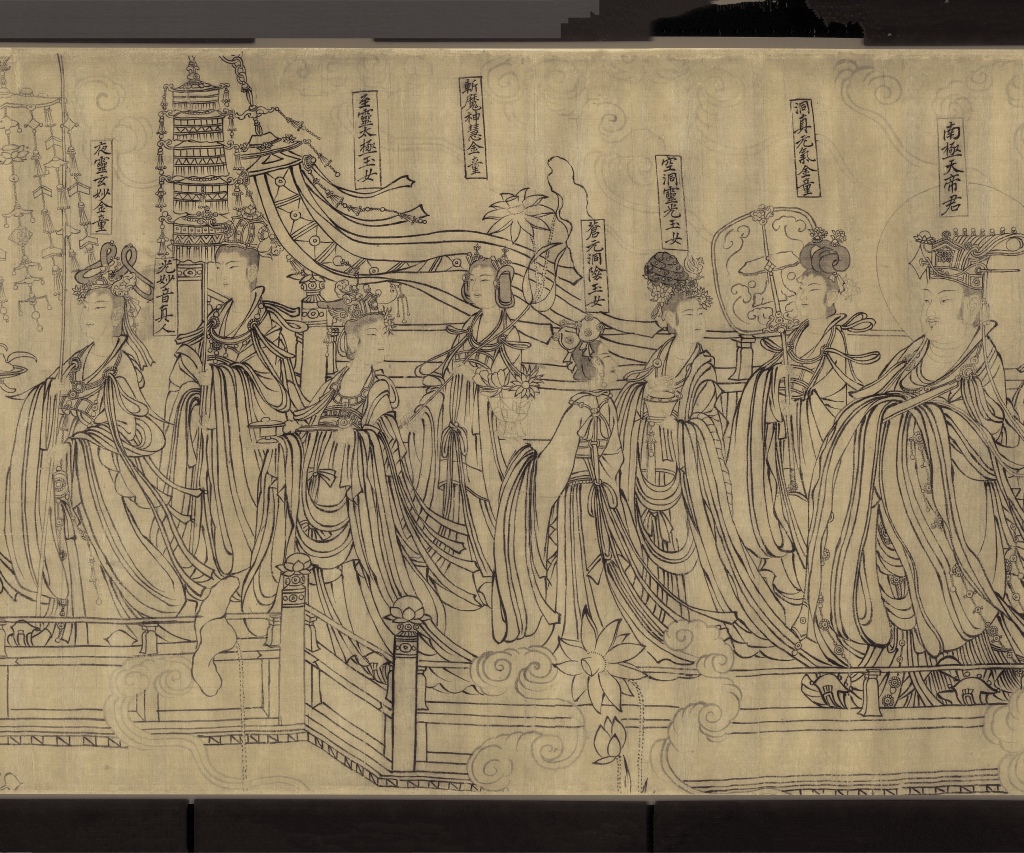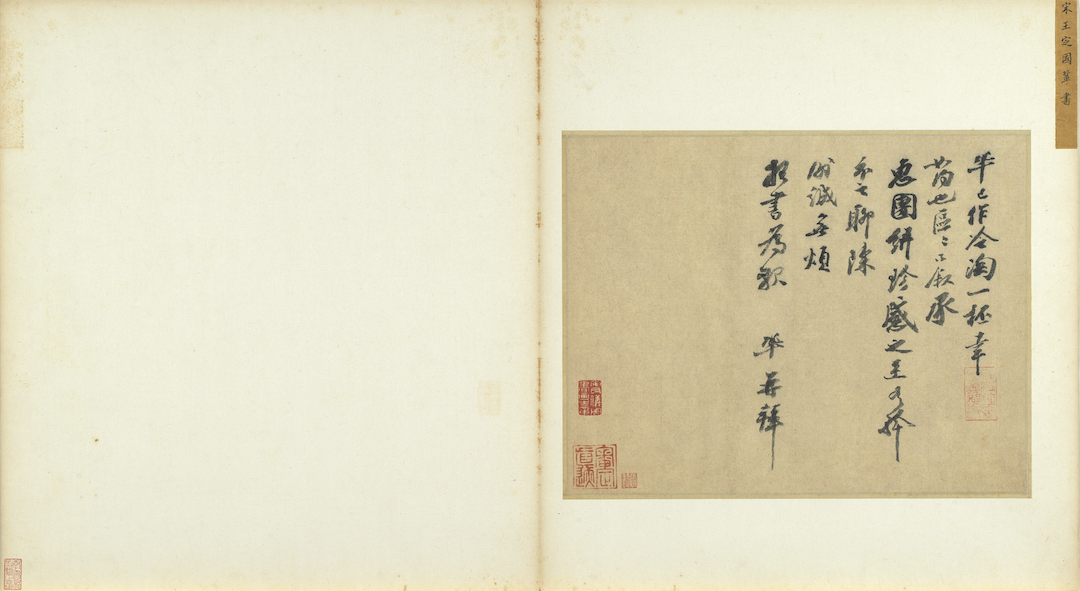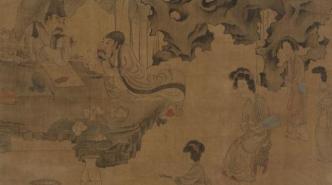
"Gao Gu Qi Hai - Chen Hongshou's Painting and Calligraphy Exhibition" is on display at Xuwei Art Museum (Shaoxing Museum Branch). "Axle, etc.
The paintings of the old lotus, whether they are figures of flowers and birds, or ink, color, or ancient figures, have a simple and quaint flavor, which is a transcendent ancient meaning that transcends time and breaks free from the constraints of space. The Paper has selected 20 key exhibits in this exhibition and interpreted them in detail for readers. The exhibition will be on view until December 20.
Avalokitesvara axis

On silk, 82 cm in length, 24.3 cm in width, in the collection of the Palace Museum
Interpretation: Western sages have no cover to teach, and they are willing to send Jiaer off. Damn, wisdom blossoms, smart Teda. The white-robed Avalokitesvara Bodhisattva Mahasattva. Awarded the reverence map to the Tuan Luan House.
Seals: "Hong Shouzhi" white seal, "Zhanghou" Zhu Wen seal.
Collection seals: "Everything is wonderful" Zhu Wenyin, "Buxiang Fumu" Bai Wenyin, "Lao Lian's Pen" Zhu Wenyin, "Ami Buddha Disciple" Zhu Wenyin.
Drawing the image of Guanyin sending children. Guanyin is female, with a broad nose and long eyes, her face is slightly old, and the white hair on her forehead shows her status as a god. The baby in his arms is dressed in red and holds a lotus flower. The author uses "nail head and mouse tail drawing" to outline the figure's clothing pattern, which is strong and square. When depicting the figure's face and hands, the lines are soft and smooth.
The combination of Guanyin and sending children is a classic case of the localization of Buddhism. According to the "Miaofa Lotus Sutra·Avalokitesvara Universal Door Pin", Guanyin Bodhisattva has the power of "responding to men and women". Since the Song Dynasty, the folks have combined the white-robed Guanyin with sending children.
Zhong Kui portrait shaft
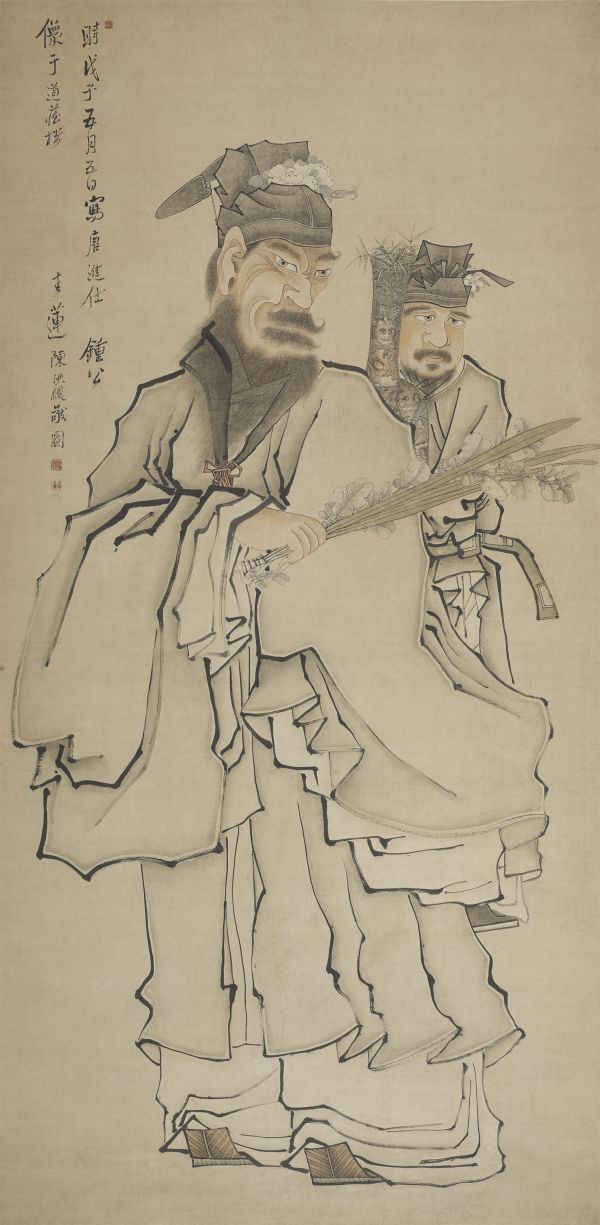
Paper, the fifth year of Shunzhi in Qing Dynasty (1648), 180.5 cm in length, 89.5 cm in width Collection of National Art Museum of China
Inscription: On May 5th, Shi Wuzi wrote the portrait of Zhonggong Jinshi of Tang Dynasty in Daozanglou, and Laolian Chen Hongshou respected the picture.
Seals: "Hongshou" in white, "Zhanghou" in Zhu, and "Lianzi" in white.
This scroll was made in Duanyang in the fifth year of Shunzhi in the Qing Dynasty (1648). In the painting, Zhong Kui has a black hat with a hairpin and a hawk-eye, holding Puai in his hand, standing slightly sideways, followed by a servant. Chen Hongshou paints the faces of the characters with light ink and colors, with vivid and delicate expressions; he uses thick ink lines to outline the folds of the clothes, and the brushwork is dignified, square, and powerful.
Butterfly lady figure axis
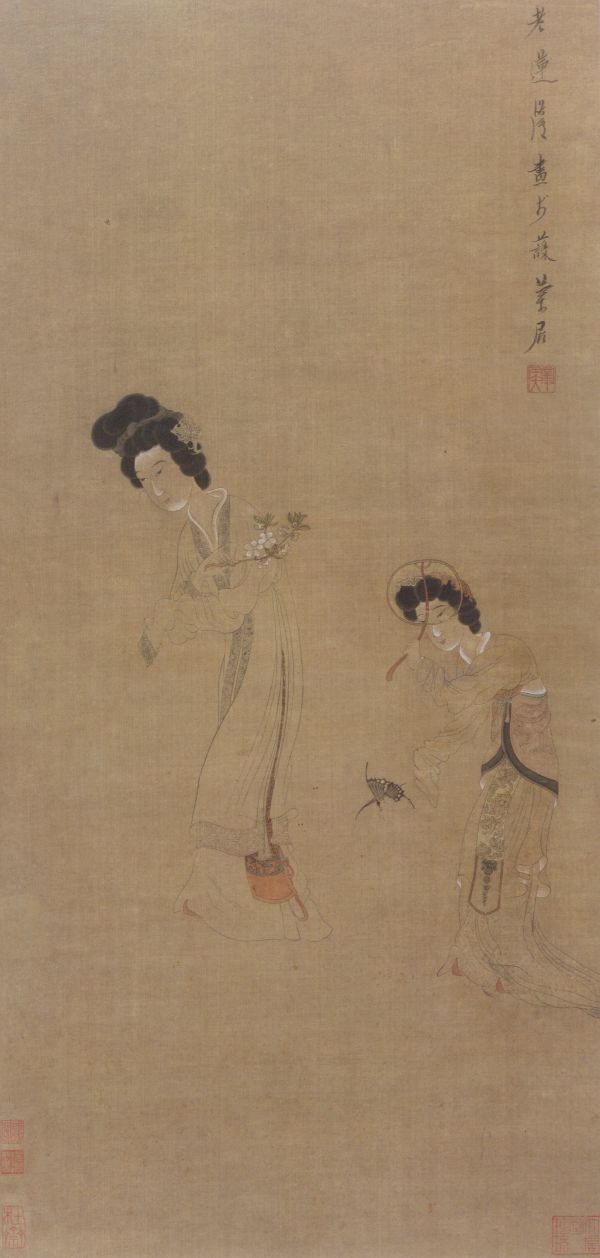
On silk, 93.7 cm in length, 45.7 cm in width Collection of Shanghai Museum
Inscription: Laolian Hongshou painted in Hulanju.
Seal: "Zhanghou" Zhu Wenyin.
Collection seals: Zhu Wenyin of "Tiaoxiao Pavilion", Zhu Wenyin of "Dafengtang Treasures", Zhu Wenyin of "Du Zhai", and Bai Wenyin of "Jianbian Pavilion".
The two ladies draw a butterfly play. The figure has a huge head and a slender body, which is a typical gesture of the old lotus lady.
Flowers, Birds, Grass and Insects
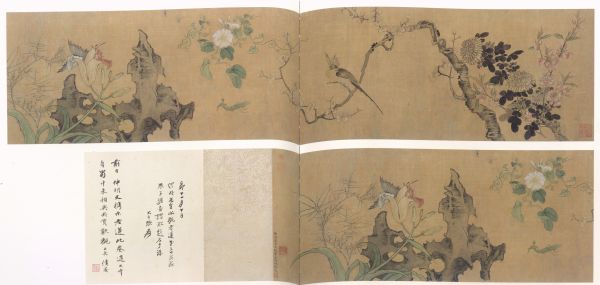
On silk, 32.6 cm in length, 161.5 cm in width Collection of Shanghai Museum
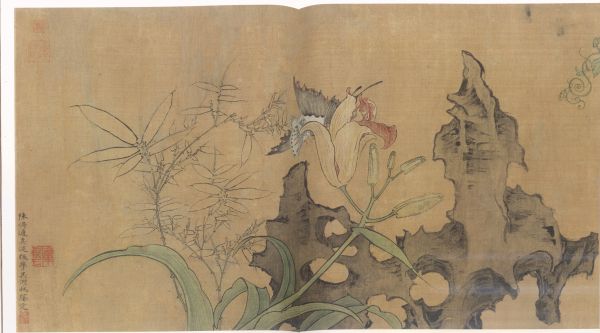
Parts of Flowers, Birds, Grass and Insects
No money
Seal: "Zhang Hou's" Zhu Wenyin.
Inscription 1: On the 10th day of the first month of the month, Mr. Zhongming went out to see the old lotus, bird and insect paper, and he happily praised the inscription on the back. Daqian Zhang Yuan.
Inscription and postscript 2: The day before yesterday, Zhong Mingzhang brought this scroll to Laolian, and it is suitable for Daqian to come from Shu. Qian An. The seal "Wuhu Fan Yin" is printed in white.
Inscription and postscript 3: Chen Huichi's authentic work, which was later appraised by Wu Hufan. Sealed in white with "Lake Sail Approval".
Collection seals: "Secretary of Gaoshi Qitu" Zhu Wenyin, "Huangshi Zhongming", "Huanglou" Zhu Wenyin, "Changsha Huangshi Huanglou Master Collection of Famous Law Calligraphy and Paintings" Bai Wenyin, "Jingtang Collection" Zhu Wenyin.
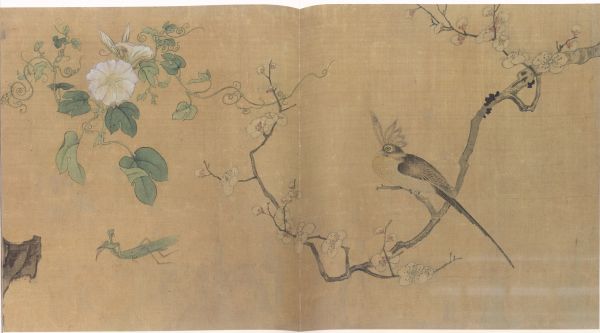
Parts of Flowers, Birds, Grass and Insects
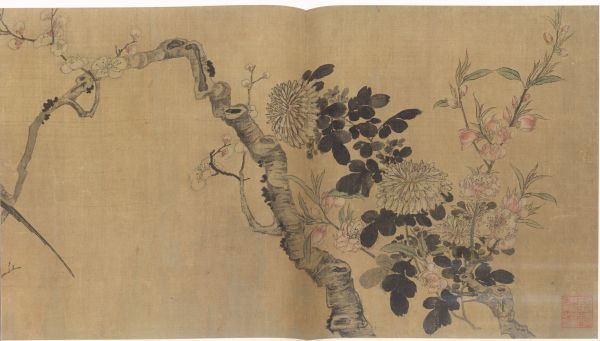
Parts of Flowers, Birds, Grass and Insects
This picture depicts flowers such as peach, chrysanthemum, plum, morning glory, bamboo, and hydrangea. Birds, nymphs, and mantises are interspersed among them. Except for chrysanthemum leaves, which are made of boneless, all others are colored with double tick marks.
miscellaneous picture book
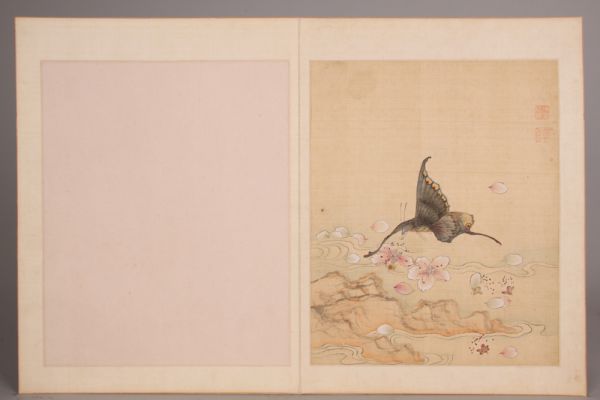
On silk, each opening is 31.7 cm long and 24.9 cm horizontal, a total of 12 openings in the collection of the Nanjing Museum
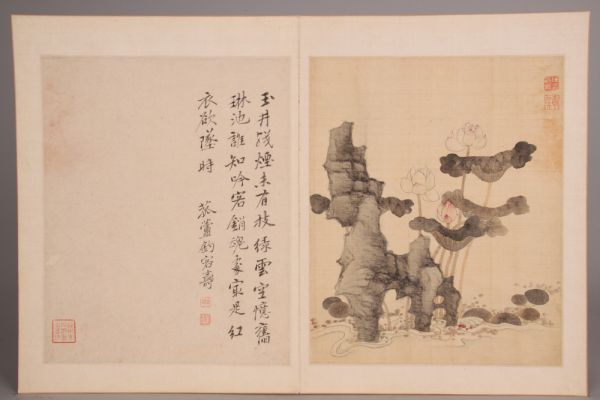
miscellaneous picture book
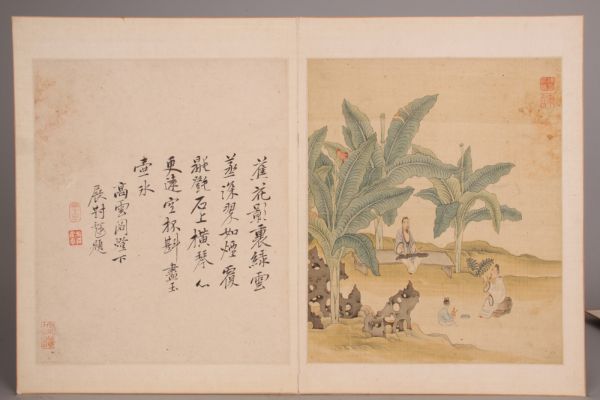
miscellaneous picture book
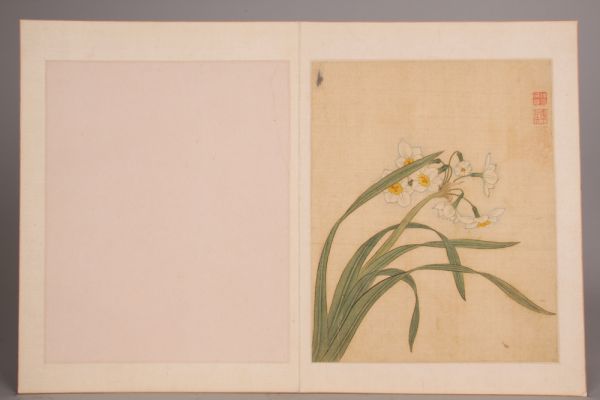
miscellaneous picture book

miscellaneous picture book
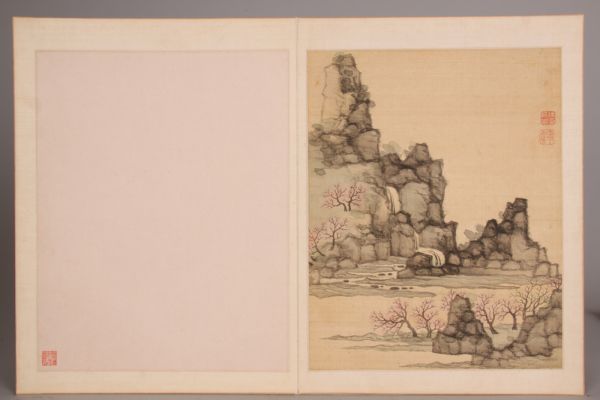
miscellaneous picture book
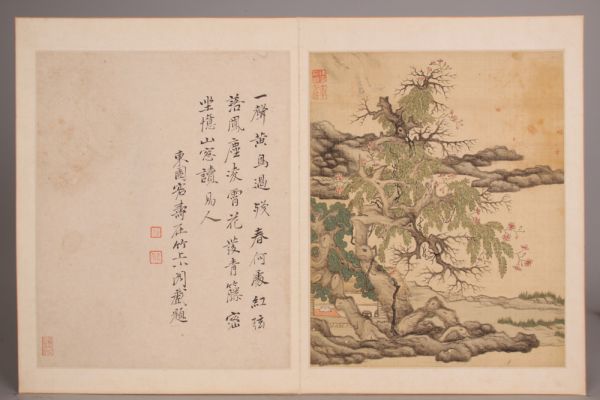
miscellaneous picture book
This album features flowers and birds, butterflies, trees and rocks, figures, etc. Five of the pages have Yun Shouping's counter-topics, which add a lot to the album. Its flowers, birds and Cordyceps are finely outlined, beautifully colored, and light and light; the lines of the figures are clear, round and fine, and the lines are clear, round and fine, and the lines are clear, elegant, and the style is vigorous.
Right Army Cage Goose Chart Axis
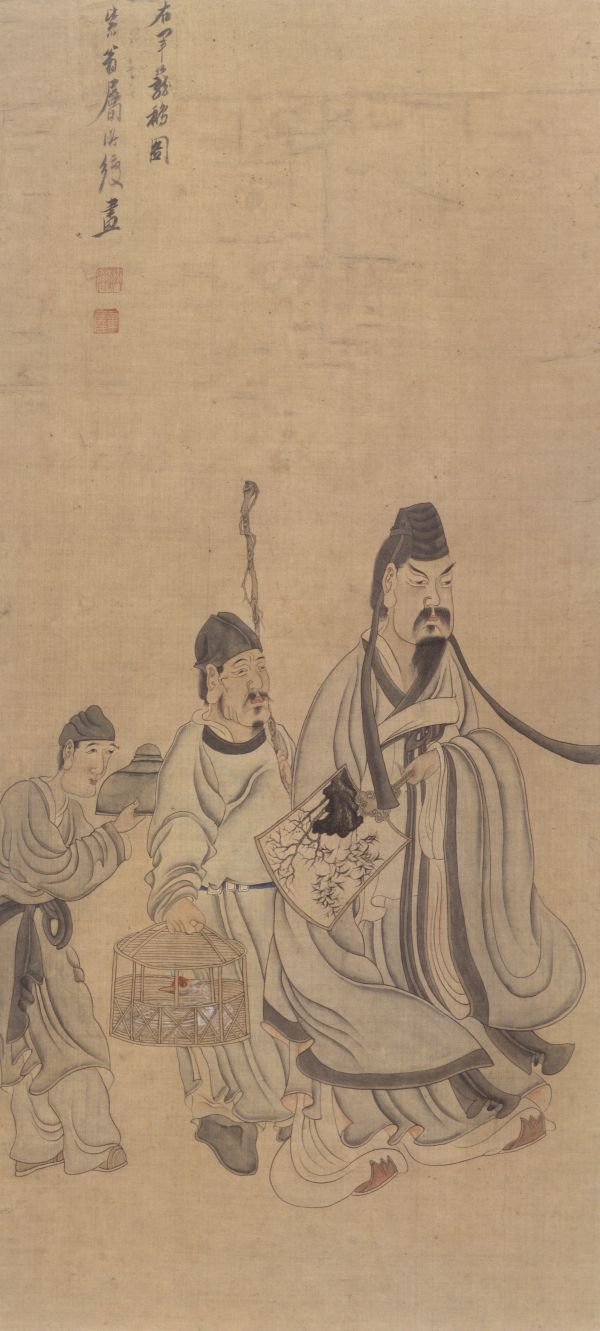
On silk, 109 cm in length and 50.5 cm in width Collection of Guangdong Provincial Museum
Inscription: Picture of a caged goose in the right army, painted by Zi Weng belonged to Hongshou.
Seals: "Hong Shou" Zhu Wen Yin, "Zhang Hou Shi" Bai Wen Yin.
The work uses the double-hook method of line drawing, the facial features of the characters are exquisitely portrayed, and the folds of the clothes are painted with ancient gossamer and light red, and the shape is exaggerated and elegant.
Finger Butterfly

Paper, vertical 25.7 cm, horizontal 17.1 cm Collection of Liaoning Provincial Museum
Inscription: Hong Shou painting.
Seals: "Hongshou" Zhu Wenyin, "Zhanghou" Bai Wenyin, "Yangengtang" Zhu Wenyin.
This painting depicts a high-ranking scholar wearing a head, holding a staff in his left hand, and a black butterfly flying towards a falling flower with his right finger in front of his feet. The gossamer drawing is extremely unrestrained, and the lines of the clothes with large sleeves and wide skirts fluctuate like flowing clouds and flowing water. The colors are simple and elegant, the face, hands and shoes are slightly covered with light ochre, and the clothes are large in light green.
Chen Hongshou Avalokitesvara Scroll
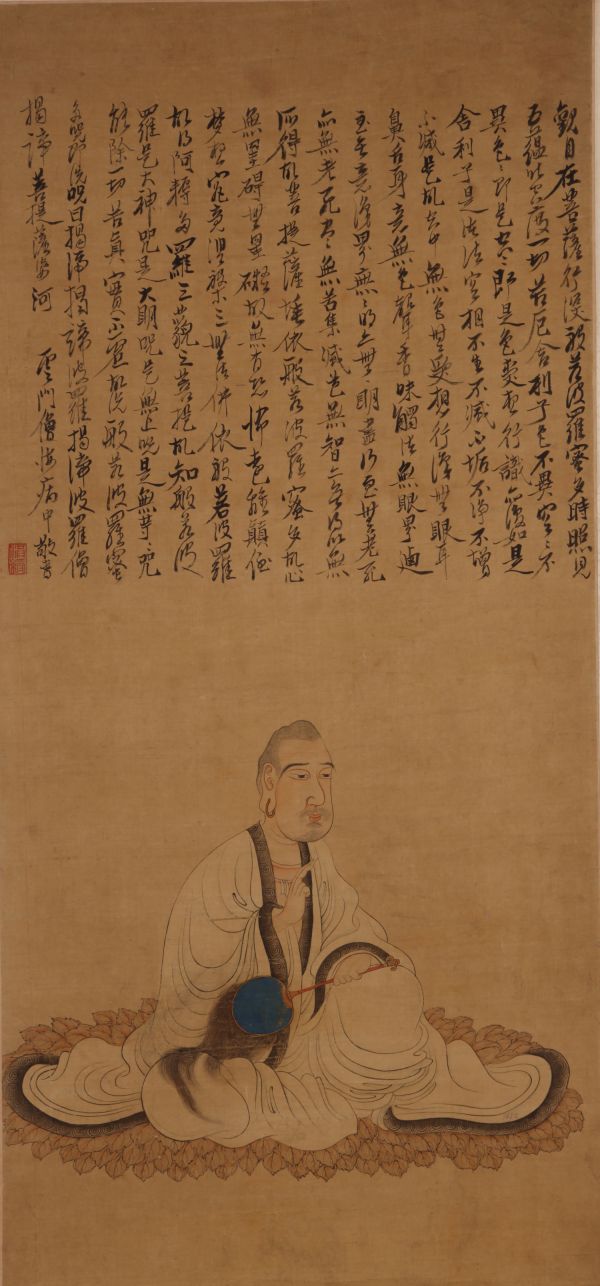
On silk, 72.5 cm in length, 34 cm in width, in the collection of Jilin Provincial Museum
Explanation: Avalokitesvara Bodhisattva, when practicing deep prajna-paramita, sees that the five aggregates are empty, and saves all suffering. Sariputra, form is not different from emptiness, emptiness is not different from form, form is emptiness, emptiness is form, and the same is true of perception, thought, action, and consciousness. Shariputra, these dharmas are empty, neither arising nor perishing, neither defiled nor pure, neither increasing nor decreasing. Therefore, the sky has no form, no feeling, thought, action, consciousness, eyes, ears, nose, tongue, body, mind, form, sound, scent, touch, Dharma, vision, and even the unconscious realm. . Without suffering, there is no path to cessation, and without wisdom, there is no gain. For nothing. Bodhisattva, relying on Prajna Paramita, has no hindrance in his mind. There is no hindrance, so there is no terror, far from upside-down dreams, ultimate nirvana. All the Buddhas of the three generations have attained Anuttara-samyaksabodhi by relying on Prajnapala. Therefore, we know that Prajna Polo is a great divine mantra, a great bright mantra, an unsurpassed mantra, and an unparalleled mantra. It can remove all suffering, and it is true and not false. Therefore, when the Prajna-Paramita mantra is said, the mantra is said: Jieti Jieji, Parajkaji, Parasangja Jieji, Bodhisapaha. Yunmen monk repents of illness and respects the book.
Seal: "Hong Shou" Zhu Wenyin
This picture depicts Guanyin sitting on a bodhi leaf, holding a whisk, and the face is artistically exaggerated, making it more graceful and generous. Gossamer's clothing pattern is even more exquisite, with a rhythm like flowing clouds and flowing water. The fine workmanship of the bodhi leaf outline shows that the painter has a solid and profound foundation. On the top of the picture is the scriptures written by the author, and later signed "Yunmen Monk Repents and Respects the Book". This scroll is a masterpiece of his handed down works in his later years.
flower book

Paper, 25 cm in length and 24.3 cm in width for each opening, a total of 8 openings in the collection of Sichuan Museum

flower book
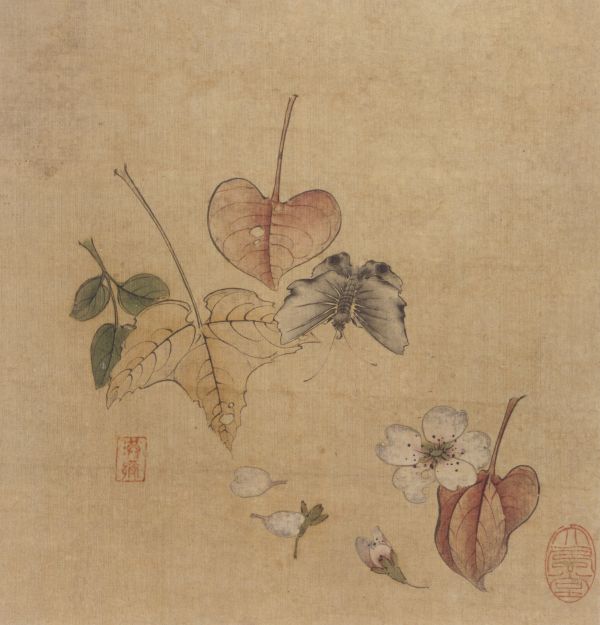
flower book

flower book

flower book
This album is Chen Hongshou's early and mid-term paintings, all in color. The flowers and plants are either fine or beautiful, and they are colorful; the ancient utensils are crafted with fine brushes, the coloring is mellow, pure and bright; the lake stones are sharp and firm, thick and condensed; the colorful butterflies and moths are agile and calm. The paintings are combined with work and writing, with rich colors and strong and beautiful lines. The picture is elegant, quaint and airy.
Huashan five old pictures

On silk, 28.2 cm in length and 184.3 cm in width, in the collection of the Capital Museum
Explanation: Ji Lingyu lays a record to Yunmen, and Master Yunli is a monk who regrets painting the bamboo scorpion Liuyi and Huashan Wu Lao. Monk repentance has been irrelevant to human affairs for a long time, how can it be possible to use pen and ink to communicate with officials? Hearing the morality of Master Li's writings, and being grateful to the layman for his honesty and kindness, how could he be proud of his officials again with a haze? Then he arrived with the five uncles and the bamboo yoke. The layhouse was located in Zhidu Temple, and was changed to Qingshui Temple. When the frost and moon are good, the layman Lao uses chrysanthemum wine, and when his mind is far away, he splashes ink and writes a pen, wishing that he will be there in the remaining months, and please ask the Dafajian.
Inscription: Hong Shou.
Seal: "Hongshou" white seal

Huashan five old pictures
This picture depicts a gathering of five elders, a game between two elders, and elder Yu watching the battle. The old man is clear and thin, with a sunken mouth, as if using a pen but without a pen, high chin and cheekbones, and very accurate facial structure. The shape is vivid, the brush is firm and soft, especially Lao Lian learns the brushwork of the Tang Dynasty, and the coloring is elegant.
Meal chart axis

On silk, vertical 107.5 cm, horizontal 45.5 cm Collection of Tianjin Museum
Inscription: Hong Shou painted on Liuqiao.
Seals: "Chen Hongshou" in white, "Zhanghou" in Zhu
Legend has it that the immortals used Ganoderma lucidum for food, and the master Yishi used to cook the medicinal herbs to cultivate their health. This picture depicts the scene of an ancient man eating Ganoderma lucidum. The characters painted are strange in appearance, exaggerated in shape, smooth and even in clothing lines, delicate and flexible, and their expressions and dynamics are finely and vividly outlined. In the composition, except for the lake and rocks, there is no background in the picture, which further highlights the temperament of the characters.
Zhong Kui portrait shaft

The second year of Shunzhi in Qing Dynasty (1645), on paper, vertical 124.5 cm, horizontal 58.6 cm Collection of Suzhou Museum
Inscription: Yiyou Duanyang, Laolian Chen Hongshou painted it in Qingteng Bookstore for Liutang Wang Mengxiong, and persuaded Pu Sheng.
Seals: "Chen Shou" in white, "Lian Baiyi" in white, "Wankuo Shutang" in white
Collection seal: Zhu Wenyin "collected by Suzhou Cultural Relics Preservation Committee"
This scroll was made in Duanyang, the second year of Shunzhi in the Qing Dynasty (1645). It is painted with light colors on Zhong Kui with black hat and hairpin, black clothes with dragon inscriptions, jade belt and scorpion, with a sword on the right and a bronze jue on the left. Puai is placed in it. Act but stand. Outline the circle, interesting and ancient.
Lady's Scroll

On silk, 24.5 cm in length, 152 cm in width, collected by Shandong Museum
Inscription: Hong Shou painted in Jianjia Garden.
Seal: "Chen Hongshou Seal" white print
Collection seal: "Guiyuntang" Zhu Wenyin
This volume is an early work of Chen Hongshou, with the inscription "Hongshou painted in Jianjia Garden" at the front of the volume. The painting method is superb, with the rhyme of Zhou Fang's "Lady with a Hairpin" between the brush and ink, which makes it more popular. A maid stood behind the housewife with a pair of phoenix fans, another maid in front was holding a flower, and another maid was holding a jug and looking back at the maid holding a vase. The meaning of the theme is unknown, but the story is complete, and it is a masterpiece of Chen's. The composition is concise and clear, and the engraving is meticulous. The scenery on the left side of the picture, such as flower arrangements, wine utensils, containers and water utensils, is simple and clear, which not only expands the picture, but does not appear empty; it is integrated with the characters and ingeniously strengthens the subjectivity of the characters. The outline of the clothes is extremely fine, the pleats are mostly drawn with hairsprings, and the belts are drawn with blue leaves. The lines are strong and strong, the squares and rounds turn, and the light and heavy setbacks can be used freely. Whether it is the characters' clothing or ancient utensils, the colors are elegant and refreshing, with the style of "ancient and elegant, quiet and pure".
plum blossom bookstore
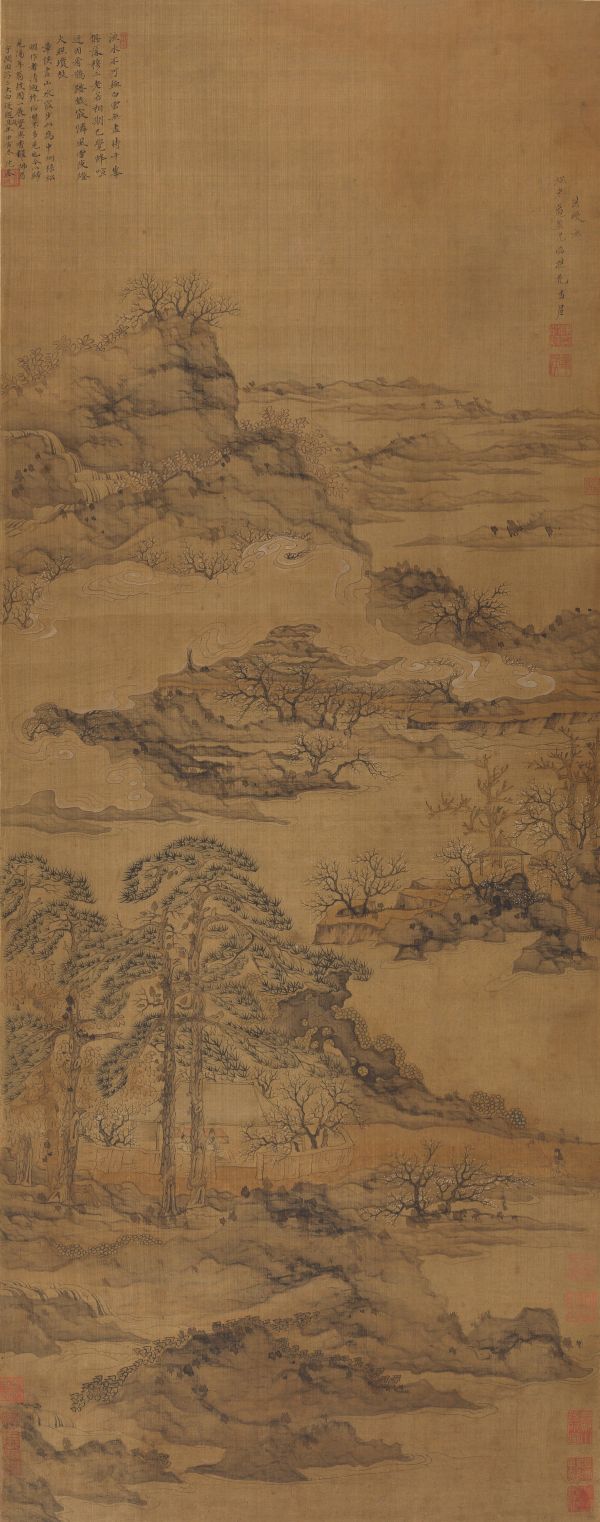
On silk, 123 meters long and 48.7 cm wide, in the collection of Anhui Museum
Inscription: Hong Shou is the brother of the Kun Laodao Alliance, and he is a bookstore with flowers.
Seals: "Chen Hongshou" in white, "Zhanghou" in Zhu
This picture is composed of flat and far-reaching methods, depicting mountains surrounded by water, cold plums exuding fragrance, and a bookstore quietly standing in the shadow of pine plums. Chen Hongshou's paintings of landscapes, trees and rocks in his later years generally have three appearances depending on the content. One is the background of the figure painting (including lake stones and stone furniture), which is the most common. The painting method is mainly based on the center line and a small amount of rubbing; the other is the tree and stone in the flower painting, and the painting method is slightly closer to Lanying; There is also a type of ink-wash or color-colored landscape paintings, which are mainly dyed and stained, with unclear patterns of cracking, and mountains and rocks are stacked upright. They are mostly seen in the works of Chen Hongshou when he lived in Hangzhou in his later years (about the sixth to ninth year of Shunzhi, 1649-1652). Based on the style of painting and the style of the inscription and calligraphy, Weng Wange speculates that this picture is the pen of Lao Lian in his later years.
Gossip Palace Chart Scroll

Paper, vertical 92.4 cm, horizontal 46.8 cm Collection of Shenyang Palace Museum
Recognition: Lao Chi
Seals: "Hongshou" Zhu Wenyin, "Zhanghou" Bai Wenyin
Collection seals: "Shiyuan Collection" Zhu Wenyin, "Wang's Baorixuan Calligraphy and Paintings" Zhu Wenyin, "Wu Yuanhui Li Quanfu's Seal of Pingshu and Painting" Zhu Wenyin, "Nanhai Wu's Nansou Zhai Secret Book" Zhu Wenyin , "Liquan Approval" Zhu Wenyin
This scroll depicts a front-facing old man sitting opposite a book-holding beauty, with a stone table topped by Chen Ping Zun and white plums. Using the gossamer drawing method, the circle is fine and healthy, and the coloring is antique.
Nanshan High Hidden Map Axis
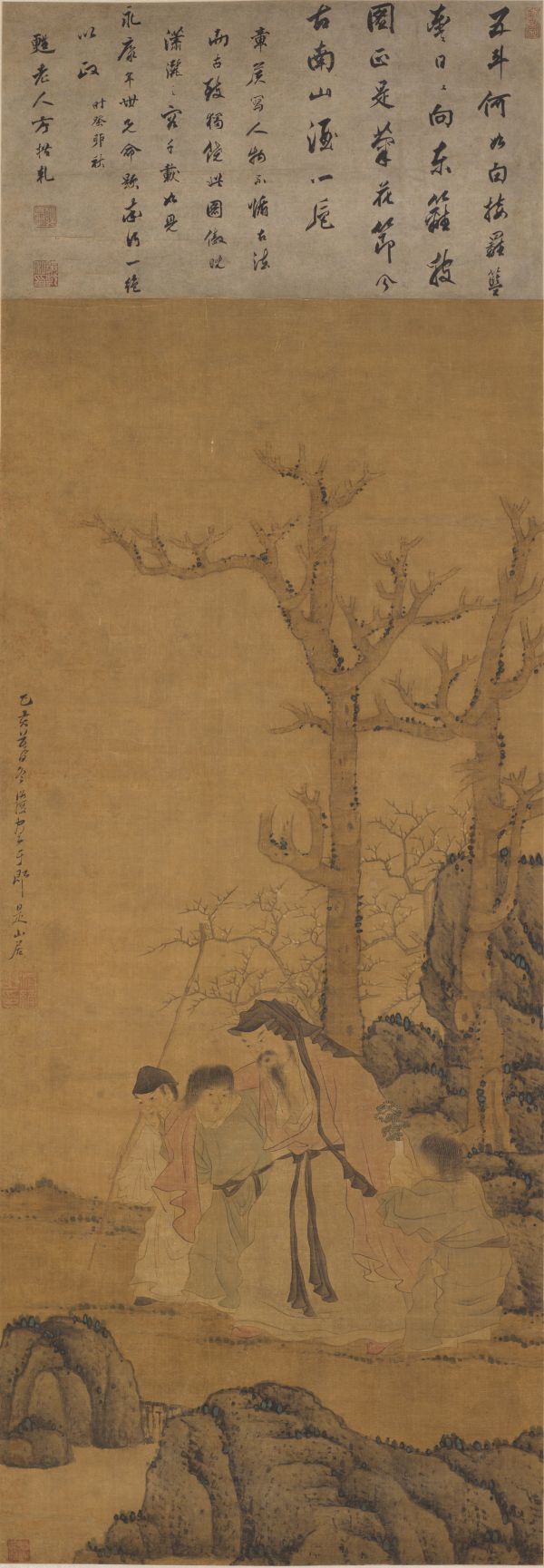
Ming Chongzhen eighth year (1635), silk, vertical 124 cm, horizontal 53 cm Collection of Wuxi Museum
Inscription: In the late winter of Yihai, the paintings of Hong Shou are mountain dwellings.
Seal: "Hongshou's Seal" in white
This work uses Tao Yuanming's poetry of picking chrysanthemums and drunkenness into the picture, vividly depicting the image of a hermit who is passionate about landscapes. In the picture, the hermit is still drunk and staggering. The three servants are either supporting, holding a staff, or offering chrysanthemums. The mood is vivid and the image is clumsy. Two towering old stems with bald branches and no leaves have a peculiar shape and are very decorative. The brushwork is fine and smooth throughout, and the tone is simple and elegant.
Lady in the mirror
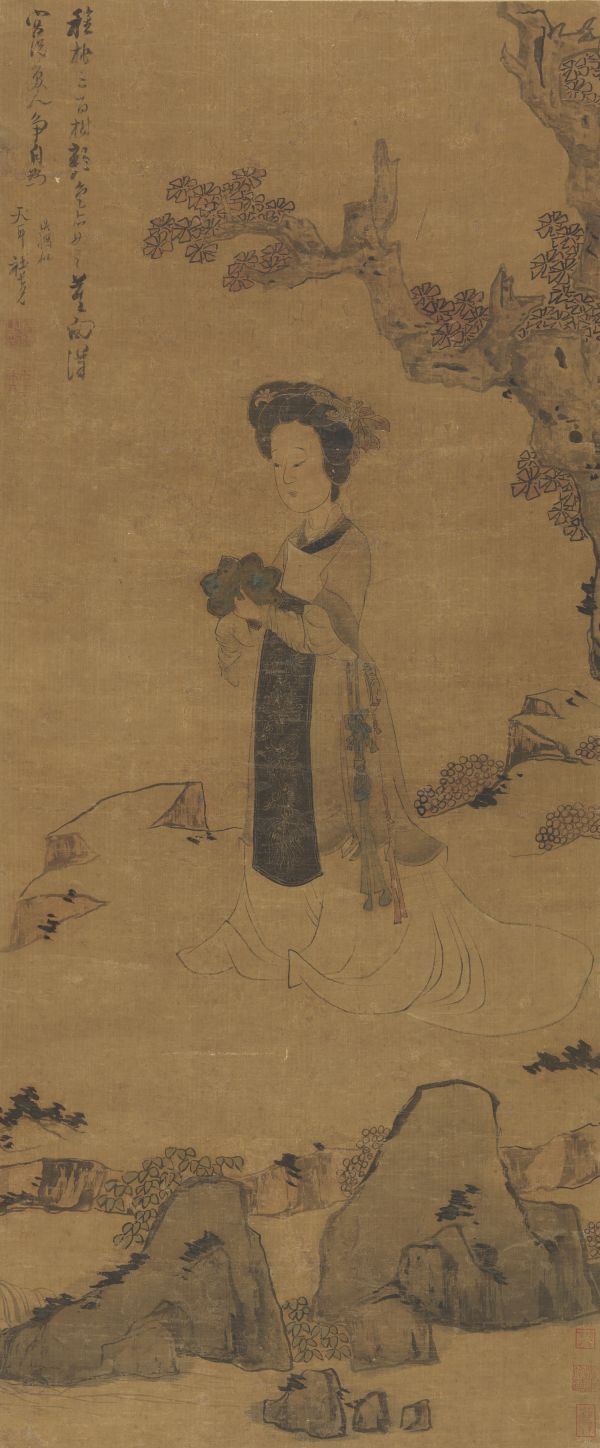
Silk Length 103.5, Width 43.2
Collection of Tsinghua University Art Museum
Explanation: Three hundred peach trees are planted, and the color is the same. Mo said to the Han Palace that beautiful women strive for themselves.
Inscription: Hong Shou is like the eldest brother of Tianer Club.
Seals: "Hong Shouzhi" white seal, "Zhanghou" Zhu Wen seal
Collection seals: Zhu Wenyin of "Yuanlei Room Collection", Zhu Wenyin of "Once in Zhu Qizhan's house"
This picture is Chen Hongshou's meticulous figure painting. The lady in the center of the picture has plump cheeks, slender eyebrows, and a slightly plump figure compared to the figure painting of the same period. The temples are tall and decorated with peach blossoms and cloud hairpins. The middle lady holds a bronze rhombus mirror in front of her chest, and bows her head slightly, looking down at the mirror, her brows are slightly sad and thoughtful. The figures in the painting have high skirts and deliberately deformed proportions, which are also visually balanced by the dark front placket and the accessories on the skirt. The peach tree sloping out from the upper right corner of the picture and several sloping rocks at the bottom of the picture are supplementary scenes that highlight the subject and adjust the picture. The color of this picture is light and elegant, the slope stone is outlined with thick or light ink color and light ochre color, the layout is appropriate and the main body is prominent. In the upper left corner of the screen, the poem is inscribed in cursive script, with vigorous and sophisticated lines.
chanting chart axis

78.8 cm in length and 47.9 cm in width on silk, collected by Yangzhou Museum
Inscription: Laolian Hongshou.
Seals: "Old Lotus" Zhu Wenyin, "Chen Hongshou Seal" Bai Wenyin
This picture shows two old men sitting opposite each other, the one with the scroll chanting, and the one with the stick listening. The colors of the picture and setting are elegant and the atmosphere is quiet; the characters are magnificent and vivid; the lines are clear, round and fine, simple and thick. It is the masterpiece of his later years.
Banana Shade Silk Bamboo Chart Axis
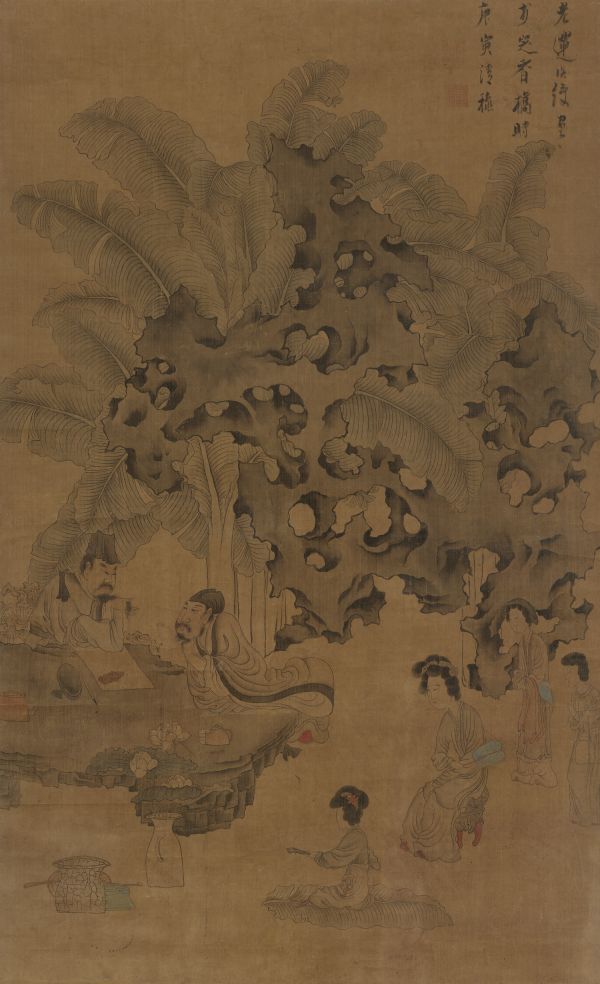
The seventh year of Shunzhi in Qing Dynasty (1650), on silk, 154.5 cm in length, 94 cm in width in the collection of Shaoxing Museum
Inscription: Laolian Hongshou painted on Dingxiang Bridge, when Geng Yin Qingqiu.
Seals: "Hongshou" Zhu Wenyin, "Zhanghou" Bai Wenyin
The picture depicts the scene of two high scholars discussing scriptures and Taoism under the shade of bananas during the Qingqiu season. Among them, the background of rockery and bananas occupies most of the picture, and there is a lady sitting on a stool with a fan on the side. Behind her stand two maids. In front of the lady, a woman faces Gao Shi and sits on a floor covered with bananas. On the ground of Ye, he was playing a musical instrument in his hand.
The overall layout of the painting is elegant and elegant, the scene is natural and harmonious, the combination of characters is clearly defined, and the shapes echo each other. With skillful brushwork, the painter outlines the delicate facial expressions and expressive gestures of the characters. The lines of clothing lines are smooth and smooth, and the ink color rendering fully expresses the texture and three-dimensionality of various objects. The whole work is based on realism, which is natural and vivid, has both form and spirit, and is full of an elegant taste of life. It is one of the representative works of Chen Hongshou's late figure paintings.
Plum appreciation axis
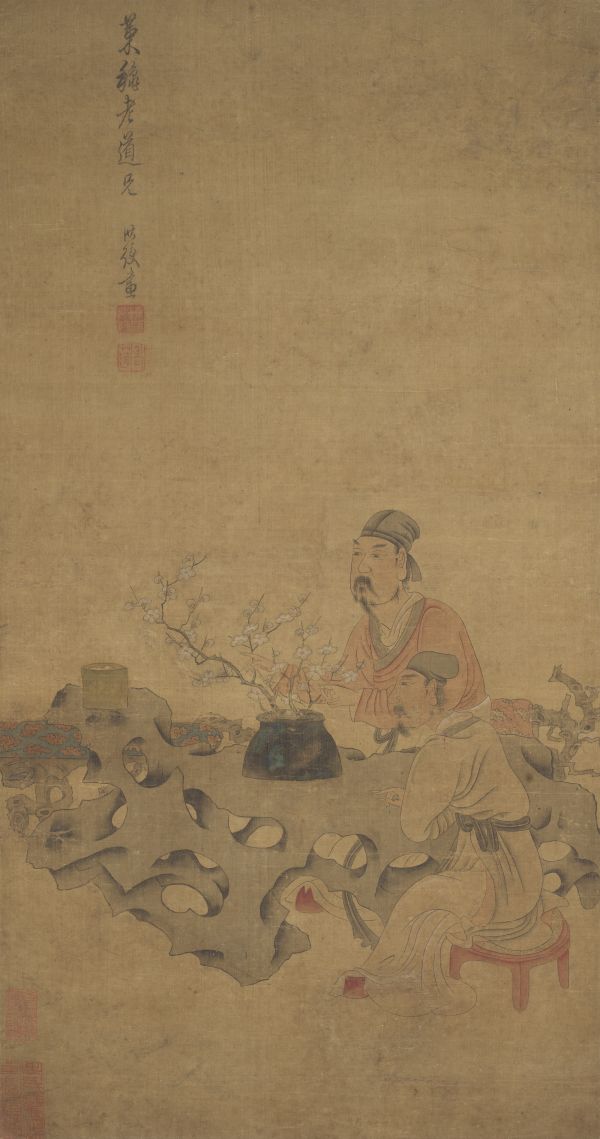
On silk, vertical 83 cm, horizontal 43.5 cm Collection of Juntao Art Institute
Inscription: Old Daoist Brother Ce Qiu, painted by Hong Shou.
Seals: "Chen Hongshou" in white, "Old Lotus" in Zhu
Collection seals: Zhu Wenyin "once protected by Qian Juntao", Zhu Wenyin "collected by the old Tengxi Bookstore"
The background of this painting is a large blank, and the openwork Taihu stone lies on the lower part, giving people a sense of quality. The white plums, the dark flowerpots, and the faces of the host and guest (especially the eyes of the two who appreciate plums) constitute the visual center of the picture. The red shoes looming under the characters' robes, the red stools where the guests sit, and the host's red clothes complement each other and echo each other. The figure's drape and hook line is purely a center forward, which is pure and full of rhythm. The technique adopts the double-hook filling color flat coating method, applying light color on the basis of the line drawing, and slightly applying ink halo on the dark part of the object image to show a three-dimensional effect. In the picture, the host pointed at the plum blossoms, as if he was introducing something to the guests.
